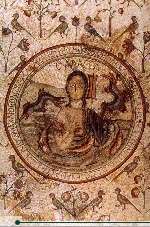 |
Keys
to the Kingdom National Anthem The Office History |
The Byzantine period dates from the year 324 CE, when the Emperor Constantine I founded Constantinople (Istanbul) as the capital of the Eastern Roman, or Byzantine, Empire. Constantine converted to the growing religion of Christianity in 333 CE. In Jordan, however, the Christian community had developed much earlier: Pella had been a center of refuge for Christians fleeing persecution in Rome during the first century CE. During the Byzantine period, a great deal of construction took place throughout Jordan. All of the major cities of the Roman era continued to flourish, and the regional population boomed. As Christianity gradually became the accepted religion of the area in the fourth century, churches and chapels began to sprout up across Jordan. |
 Personification of the sea medallion, Church of the Apostles, Madaba. |
Many of these were clustered together on the foundations of ancient Roman settlements, and a good number of pagan temples were plundered to build churches. Church-building witnessed extraordinary growth during the reign of Emperor Justinian (527-65 CE). Most of these churches were of basilica type, with semi-circular apses to the east and two parallel rows of pillars supporting a higher roof over the nave. |
 Mosaic Map of the Holy Land. |
One indication of the prosperity of the period can be seen in the mosaic floors which decorated many of these newly-built places of worship. These ornate mosaics often portrayed animals, people and towns. The most impressive examples of Byzantine mosaic artistry can be seen in Madaba, and the greatest of these is the famed sixth-century Map of the Holy Land, also known as the Mosaic Map of Palestine. |
| In the sixth and seventh centuries CE, Jordan suffered severe depopulation. The plague of 542 CE wiped out much of the population, while another cause may have been the Sassanian invasion of 614 CE. The Sassanians, who had ruled Persia and Iraq since the early third century CE, occupied Jordan, Palestine and Syria for fifteen years, but the Byzantine Emperor Heraclius managed to recover the area in 629 CE. His gains were not to last for long. |